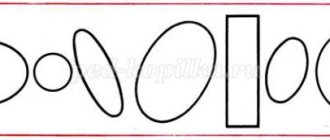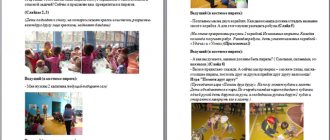MAGAZINE Preschooler.RF
Summary of the quest - games for the formation of elementary mathematical concepts in the senior group “In search of the “Book of Memory”(as part of the thematic week “These days the glory will not be silent” )
Authors:
- Logutova O.V.
Co-authors:
- Zelenova N.V.
- Rozhkova S.N.
MBDOU "Kindergarten No. 5 "Beryozka" Alatyr, CR
Program content:
- practice counting to 10;
- fix numbers from 0 to 9;
- consolidate knowledge about geometric shapes; (circle, square, quadrangle, rectangle); develop geometric vigilance;
- improve the ability to navigate on a sheet; understand the meaning of spatial relationships;
- develop the ability to solve logical problems, think, reason, prove;
- develop readiness for joint activities; ability to work in a team, moving towards a common goal;
- develop logical thinking, memory, attention, creativity, hand motor skills;
- to foster a sense of pride and respect for family and friends who took part in the battles for their homeland
- cultivate the ability to communicate with each other, negotiate, follow the rules of the game, and enjoy collective creative activity.
Types of activities: cognitive, gaming, communicative, motor, constructive.
Materials, equipment: search map, “Book of Memory” , arrows of 3 colors, laid out on the floor; sets of geometric shapes for each child, samples of tanks, a sample “tank - pocket” , hummocks with numbers, imitation of a swamp, circles with numbers from 1 to 10.
Progress:
Educator:
- Guys, I’ll show you an interesting and unusual book - “The Book of Memory” . It tells about the exploits of our great-grandmothers and great-grandfathers who fought in the Second World War. But since this book is unusual, it is locked.
- How do you think? What do you need to do to open it? (find the key)
— In the army, scouts do searches, but in everyday life this is done by search teams, detachments of Youth Army members.
-Who would you like to be before you go looking for the key?
Educator: - For searches, scouts use a map, I also have a map, it is needed in order to complete tasks and find the key. For each completed task we will find a key of a different geometric shape.
— Let's see (unfolds the map), where are we? (children find the beginning of their journey)
- Which color arrow will we start moving along?
-Where will she lead us? (in the forest)
(Children begin to move along the green arrows fixed on the floor)
- Here we come to the forest. We need to navigate correctly so as not to get lost
(On the stand there is a schematic image of a forest: fir trees, a pocket - “den” , sun, cloud)
Educator:
— What is in the upper right corner? (there is a cloud in the upper right corner)
— What is in the lower left corner?
-Where is the sun?
— What is in the lower right corner? (den)
- Who sleeps in a den in winter? (opens the pocket - “den” , takes out the key)
Educator:
- Guys, here is the first key.
- Let's look at the map again. What will be our next step? (guided by the map) Where does the arrow point? (on the tank battlefield)
- Look how many destroyed tanks there are here. I'm guessing there was a serious fight here. You may need our help.
— We form a column one at a time.
(Children follow the red arrows. Stop “Battlefield” ).
Physical education minute
We walk together in a row. Our scout squad! We are brave guys, dexterous, skillful!
Educator:
- Guys, we found ourselves on the battlefield. (there are sets of geometric shapes on the tables)
— All military equipment here is destroyed and requires repair. (pay attention to samples of tanks assembled from geometric shapes)
— What geometric shapes are the tanks made of?
— How can they be repaired? (made up of geometric shapes)
- To complete this task, we will split into pairs, sit at tables and assemble military equipment from figures (children complete the task).
Educator:
-You completed the task, I give you a hint. The key is located under the tank as in my picture. Look carefully, where is this tank? Well done! You found the second key (the key is on the “tank-pocket” )
Educator:
- Let's look at the map again. Where do we need to go next? What color are the arrows showing us the direction?
- What kind of place do you think this is? (swamp). Let's hit the road.
(Children move along the blue arrows)
- Guys, there is a swamp in front of us. How can you cross it? (over bumps).
-That's right, to cross it you need to use the bumps (with numbers). But not every bump can be stepped on.
— To find out which bumps are safe, let’s solve logical problems.
(Having guessed the number, cover the desired bump with a circle of a different color with the image of the guessed number)
- On the shelf stood: a tank, an airplane, a samovar and a ship. How many toys are on the shelf? (Three. A samovar is a utensil.)
- Birds flew over the river: a pigeon, a pike, three tits. How many birds, answer quickly.
- How many fingers are on one hand? (5)
- How many days are there in a week?
- What numbers have we discovered? (3, 4, 5, 7)
— Can we step on bumps with these numbers? (children walk over “safe” bumps)
-Guys, we passed the swamp and there should be a key here somewhere.
Educator:
- Let's look at the map again, it will tell you where it is. (the map shows a hummock under which the key lies)
— Our route is completed. All the keys have been found, and our task is to find the key to the lock. (children find the key according to the lock)
“We went through a difficult path, completed all the tasks and opened the book.
Educator:
— What did you like about our trip?
— Which task did you find most difficult?
— Which is the most interesting?
- Guys, I had an interesting time with you. Thank you for being active, friendly, and savvy. And as a reward we will watch “The Book of Memory” .
(Children open and look at the book)
Used Books:
- Andreeva, A. D. The problem of play motivation of modern children // Journal of practical psychologist. – 2008 – No. 5.
- Gavrishova E.V., Milenko V.M. Quest - an adventure game for children // Directory of a senior teacher of a preschool institution. – 2015 – №10
- Mikhailova Z. A. “Game entertaining tasks for preschoolers”, Moscow “Enlightenment”, 1985.
- Mikhailova Z. A., Ioffe E. N. “Mathematics from 3 to 7”, St. Petersburg “Accident”, 1998.
- Nosova E. A., Nepomnyashchaya R. L. “Logic and mathematics for preschoolers”, St. Petersburg “Accident”, 1996.
- Pomoraeva I.A., Pozina V.A. Federal State Educational Standard Formation of elementary mathematical concepts in the senior group of kindergarten. Lesson plans. M.: Mosaika-Sintez, 2016.
- From birth to school. Basic general education program of preschool education / ed. NOT. Veraksy, T.S. Komarova, M.A. Vasilyeva. M.: Mosaic Synthesis, 2016).
| Next > |
Math quest and how to do it
The word “quest” comes from the English “quest”, “goal, task”; this word is also used to mark tasks in games, both computer and tabletop. In other words, a quest is a chain of tasks presented in a game form.
Note! Such an event can be done with or without a plot.
For example, children aged 5–6 years are still interested in watching the story about Baba Yaga and Little Red Riding Hood, but children aged 6–7 years may feel a little awkward.
Then it is better to put the quest in a more “adult” form, calling it, say, “Sports Math Quiz,” or make a story where the main character will be a detective, and he will investigate the case of missing answers to questions in a test. If the institution has a projector, then a background video can be installed to create the appropriate atmosphere. In order not to waste time downloading, you can launch it online. It is precisely these nuances that distinguish truly entertaining mathematics for children from ordinary lessons.
Nothing makes an event more interesting for children than the opportunity to have fun
Important! It is necessary to understand that the quest is, first of all, an entertaining event, and the teacher must be prepared for the fact that the interest of children is more important than the quality of the information conveyed.
Thematic week “Professions” in the middle group
This is not a lesson, a test, or a test. A good math riddle for children is one in which he wanted to find the answer, but not one where the answer was complicated and boring. Also, the child must have a reason to participate in a strange and incomprehensible action. Such a reason could be a certificate or a sweet prize.
The process of creating a quest looks like this:
- Come up with a story or reason why children will have to solve certain problems.
- Divide the quest into several stages (more on this below).
- Distribute the locations, keep in mind that in order to carry out the quest efficiently, you will have to distribute the children into groups of no more than 5 people, otherwise it will not be possible to pay enough attention to everyone at each stage. (If there are not enough teachers to work in parallel, you can conduct a regular lesson with part of the group, and a quest with the other, and swap them in the next lesson. (Or conduct a KVN, but more on that later).
Each quest should have the following several parts:
- The initial stage, in which you need to explain to the children what is happening now, talk about the rules of behavior in such a lesson. It is worth limiting yourself to a few easy tasks, giving priority to the involvement and interest of children.
- The main action in which children will move around locations and solve problems.
- The culminating part, in which the winners, if any, will be awarded (the best way out here would be to allocate first place, and give the rest diplomas / awards “for active participation”, “for the best poem”, etc.).
- Summing up is an important point that many scripts miss. A child always wants to feel important and grown up; he appreciates being appreciated. It is necessary to divide the children into groups and give them the opportunity to speak out about what happened, after which they should be carefully led to the idea that mathematics is more interesting than it seemed before. At this moment, the teacher should not be too persistent: feeling that someone else’s opinion is being imposed on him, the child may close himself off from the subject for a long time.



